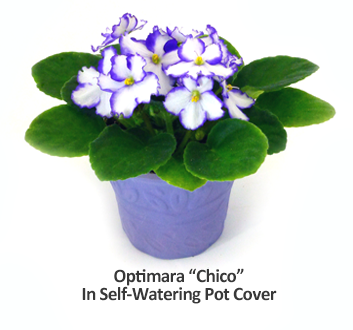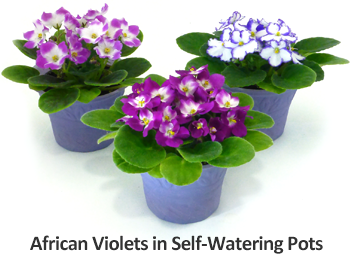As the problem gets worse your plant will stop growing wilt and develop brittle leaves. The first sign that your African Violet is running out of space is that the foliage is more than 3 times as wide as the pot.

Plant Care Instructions For African Violets
African Violet Pro tip.

. These enduringly popular and compact houseplants offer charming flowers in various colours from traditional violet through shades of mauve blue pink red and white. Water the African violet the day before you intend to separate the pups. Push aside the surrounding soil to fit the root ball into the hole.
Step 1 Remove all older leaves that are smaller than the leaves above or are faded in color or nicked and damaged. To do this place the African Violet into a clear plastic bag which is large enough to accommodate the plant without damaging the leaves or stems. Save to My scrapbook.
Brush away the loose soil and dust from the pot. If the plantlets dont have any size to them yet its too early. Transplanting African violets Since the new pot is not much bigger you wont have to add too much growing mix.
Growing violets in a humid climate will require a higher percentage of large-particles such as coarse perlite. Now lets go over the six easy steps to repotting your African violet. It might seem silly but room temperature plays a part in new root growth.
When they bloom you should transplant them into 3 pots until your plant gets bigger 8 to 10 in diameter. Recall indirect sunlight is not the same thing is direct sunlight. If its struggling to bloom or its soil is retaining too much water you may want to size down.
If your plant is root-bound itll be happier in a slightly bigger pot. Slide the mother plant carefully out of the pot. African violet with a neck.
Keep water from touching their leaves or it will leave brown spots. Loosen Your African Violet from its Current Pot. Then fill a 2 inch 5 cm clay or plastic container with a commercial potting mix consisting of peat and perlite or any well-drained mix.
The root ball should sit in a hole on top of the soil you packed earlier. Center the violet in the middle of the pot. A quality African violet potting mix should provide good water-holding capacity and ample air pockets to guarantee healthy roots.
To loosen the plant from the pot gently tap the sides of the pot against a hard surface. I rarely leave more than about 10 leaves total. Typically we want our African Violets to get a full day 11-14 hours of indirect sunlight.
Repotting can also lead to wilting of African violet plants. After you have removed the Violet from the bag it will be safe to resume your normal watering and fertilizer schedule. Remove dead flowers and leaves as soon as you see them to encourage a healthier plant.
If the grower has a specially equipped rack with lighting and can regulate the temperature in the room then he can transplant flowers all year round. Carefully tease or wash away the loose soil from the top and sides of the roots without damaging them. Indirect sunlight refers to placing your African Violet in a bright windowsill or somewhere else where the sun wont be beaming down on it directly.
Again we should have been waiting for 4-6 months for this moment. During these days the plants primary concern is optimizing the healing and growth of its roots. Ensure the baby violets are ready.
Pre-moisten the soil lightly before planting. Seal the bag with a wire twist. Step 2 Use the dull side of a knife to scrape about two inches of the stem gently that.
Regularly check the soil and plant to make sure there is no accumulation of dead leaves. The main points required for a successful transplant. Great transplanting skills can make violets thrive.
Remove plant from its pot and remove the bottom of the root ball an amount equal. Transplant your African Violet to a bigger pot and give it some breathing room. If it still doesnt loosen you may need to slide a knife around the edges.
Since youre working beneath the leaves and dont need to add more soil this should be easy to do without making a mess. The blooms are clustered above a rosette of furry leaves. Working with your fingers beneath the leaves move around the pot and gently press and smooth the soil.
You should then loosen the root ball of your African violet fill the remaining space and press lightly around the plant. Given the right growing conditions African violets can flower non-stop for months on end. When you move this plant to a new pot it faces severe water deficiency and transplant stress for some days.
The move will stress out its roots so let it get a big drink first. Once they overwhelm the pot first flowers will likely appear but to keep a healthy plant growth for future seasons repotting after the pause in blooming is essential. The light must reach the plant within 11 hours.
Tip 1 Choose the right potting mix for your climate. Be careful when removing the plant from its old housing. African Violet Wilting Because of Transplant Shock.
Add a small amount of bone meal if you wish. Then once removed take the knife and slice off the bottom third of the root ball. Replanting the Violet Download Article 1 Lower the root ball into the new pot.
The temperature on the windowsill at night should not drop below 19 degrees Celsius. African Violet Repotting Step By Step 1. Keep your Violet in the bag for one week.
How cold is it in your home. Dont use a larger pot as too much damp potting mix can rot the pup. Youll either return your plant to the same pot or transfer to a different-sized container.
Gently tap the sides of the pot against a hard surface to loosen the plant from the pot according to Martha. African Violet Care African violets will thrive in bright warm and humid conditions. Its best to do it while the plant isnt in bloom.
Youll probably want to correct your African Violets long neck once or twice a year to keep it looking nice. Here are some repotting tips to help you develop your green thumb. First make sure that the plantlets are ready for separationtransplantation.
If you start new African violet plants from leaves in water youll need to transplant them once they have a good set of roots and a small new plant at the base of the old leaf. Its also a good idea to water your plant thoroughly the day before you transfer it. You may need to loosen the soil a bit and then turn the plant over cradling it in your hand gently and push into the drainage holes.
Preparation First prepare your tools and space. A neck is the palm-tree like trunk that appears over time as the lower rows of. Hold the plant by the leaf stem over the new pot.
Lift the leaf from the water. When finished youll have a still-blooming freshly potted violet. When transplanting three plantlets or cuttings is the most that can be placed together in a pot until all the plantlets grow enough to be separated.
Cut-away bottom of root ball. If necessary slide a knife around the edges. Dealing with Necks Step 1.
For this use 1 part each garden loam sand and peat moss.

How To Repot African Violets Empress Of Dirt
African Violets Restoring Or Restarting Violet Barn

Plant Care Instructions For African Violets

How To Grow African Violets Caring For African Violets

Repotting African Violets Garden Answer Youtube

How To Repot African Violets Empress Of Dirt

Repotting African Violets When To Repot An African Violet Plant
0 comments
Post a Comment